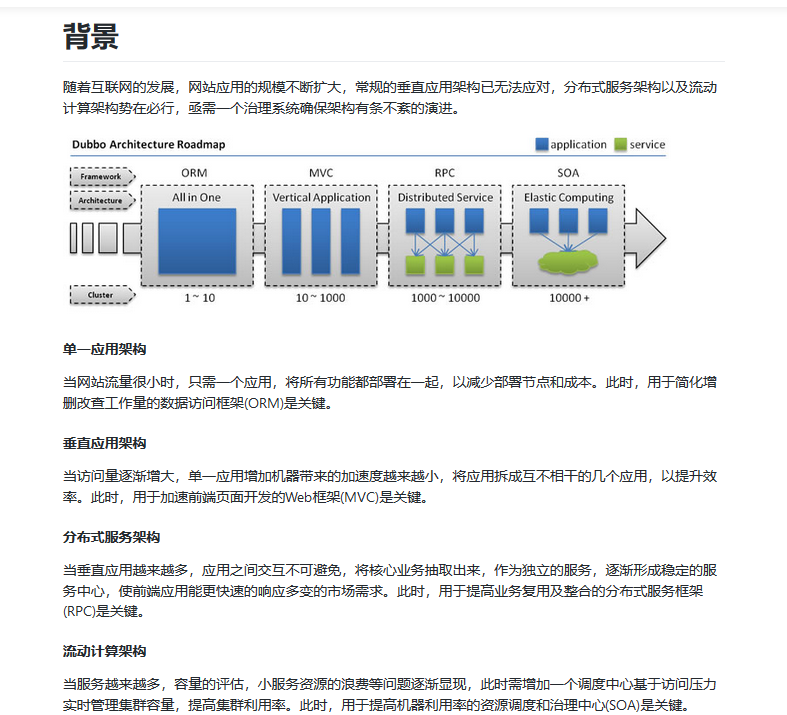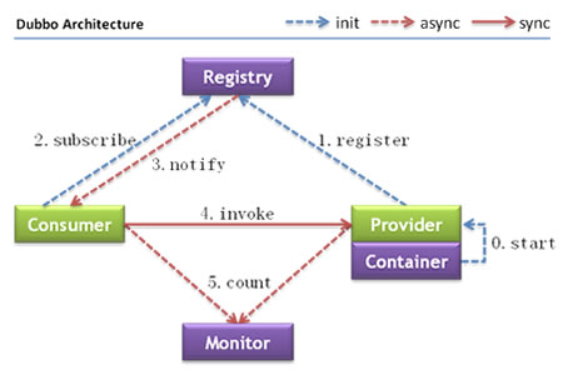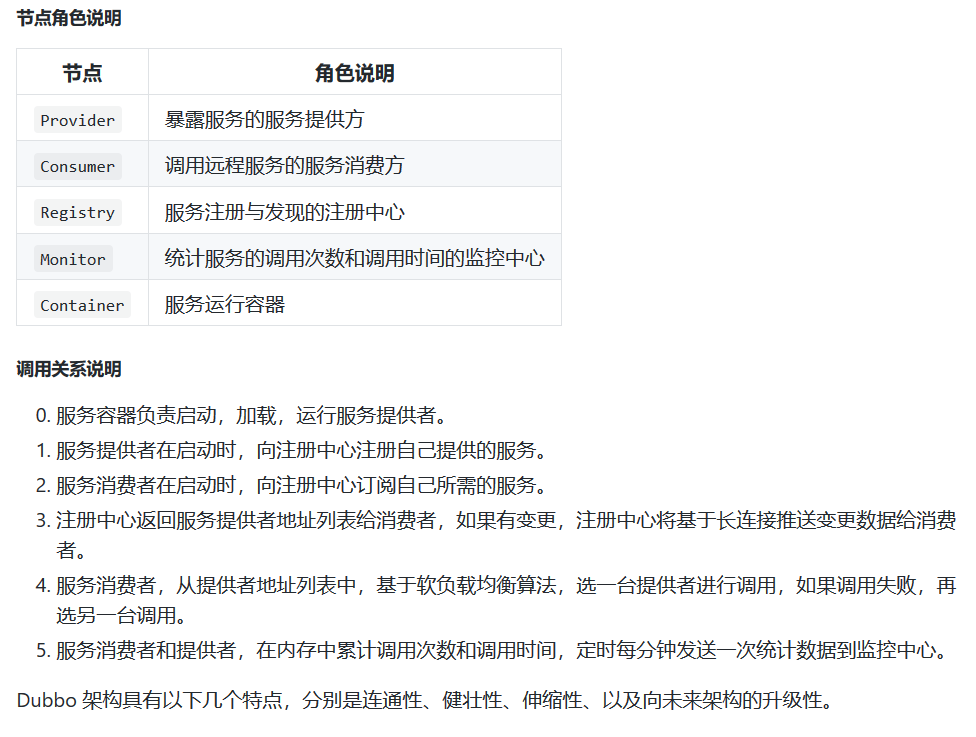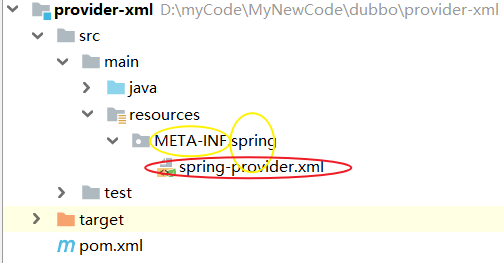I. background of Dubbo's birth (excerpt Dubbo official website - Introduction - background)

II. Dubbo structure chart (excerpt) Dubbo official website - Introduction - Architecture)


3. Dubbo core dependency (jar package): Dubbo, zkclient
IV. construction methods of Dubbo project: profile and annotation
V. core configuration of Dubbo project configuration file:
(I) profile
1. Service provider (following example): ① application name ② protocol (dubbo protocol recommended) ③ registry ④ exposed service interface ⑤ implementation class bean object of exposed service interface
<?xml version="1.0" encoding="UTF-8"?> <beans xmlns="http://www.springframework.org/schema/beans" xmlns:dubbo="http://code.alibabatech.com/schema/dubbo" xmlns:xsi="http://www.w3.org/2001/XMLSchema-instance" xsi:schemaLocation="http://www.springframework.org/schema/beans http://www.springframework.org/schema/beans/spring-beans.xsd http://code.alibabatech.com/schema/dubbo http://code.alibabatech.com/schema/dubbo/dubbo.xsd"> <!--Configure provider application information for dependency calculation--> <dubbo:application name="provide-xml"/> <!--Configuration Protocol (using dubbo Protocol at 20880 port(dubbo Protocol default port)Exposure services)--> <dubbo:protocol name="dubbo" port="20880"/> <!--Configure the registry to expose service addresses--> <dubbo:registry address="zookeeper://192.168.110.11:2181"/> <!--Configure interfaces for exposed services--> <dubbo:service interface="com.bjsxt.dubbo.service.ITPService_xml" ref="dataServiceImpl"/> <!--Register the implementation class of the exposed service interface bean object--> <bean id="dataServiceImpl" class="com.bjsxt.dubbo.service.impl.ITPServiceImpl_xml"/> </beans>
2. Service consumer (example below): ① application name ② registration center ③ service interface exposed by provider
<?xml version="1.0" encoding="UTF-8"?> <beans xmlns="http://www.springframework.org/schema/beans" xmlns:dubbo="http://code.alibabatech.com/schema/dubbo" xmlns:xsi="http://www.w3.org/2001/XMLSchema-instance" xsi:schemaLocation="http://www.springframework.org/schema/beans http://www.springframework.org/schema/beans/spring-beans.xsd http://code.alibabatech.com/schema/dubbo http://code.alibabatech.com/schema/dubbo/dubbo.xsd"> <!--Configure the consumer application name to calculate the dependency. It is not a matching condition. It should not be the same as the provider--> <dubbo:application name="consumer-xml"></dubbo:application> <!--Configure registry to expose discovery service address--> <dubbo:registry address="zookeeper://192.168.110.11:2181"/> <!--Declare the exposed service interface of the service provider to be called (provided that the interface has been copied to the business layer of the consumer)--> <dubbo:reference interface="com.bjsxt.dubbo.service.ITPService_xml" id="iTPService"/> </beans>
(II) annotation
1. Service provider (example below): ① application name ② protocol ③ registration center ④ dubbo annotation scanning
<?xml version="1.0" encoding="UTF-8"?> <beans xmlns="http://www.springframework.org/schema/beans" xmlns:dubbo="http://code.alibabatech.com/schema/dubbo" xmlns:xsi="http://www.w3.org/2001/XMLSchema-instance" xsi:schemaLocation="http://www.springframework.org/schema/beans http://www.springframework.org/schema/beans/spring-beans.xsd http://code.alibabatech.com/schema/dubbo http://code.alibabatech.com/schema/dubbo/dubbo.xsd"> <!--Configure provider application information for dependency calculation--> <dubbo:application name="provide-annotation"/> <!--Configuration Protocol (using dubbo Protocol at 20880 port(dubbo Protocol default port)Exposure services)--> <dubbo:protocol name="dubbo" port="20880"/> <!--Configure the registry to expose service addresses--> <dubbo:registry address="zookeeper://192.168.110.11:2181"/> <!--To configure dubbo Annotation scan(Annotating: Using dubbo Annotations@Service To replace the other two configurations)--> <dubbo:annotation package="com.bjsxt.dubbo.service.impl"/> </beans>
2. Service consumer (the following example): ① application name ② registration center ③ dubbo annotation scanning ④ declare the business layer implementation class bean object of the exposed service interface
<?xml version="1.0" encoding="UTF-8"?> <beans xmlns="http://www.springframework.org/schema/beans" xmlns:dubbo="http://code.alibabatech.com/schema/dubbo" xmlns:xsi="http://www.w3.org/2001/XMLSchema-instance" xsi:schemaLocation="http://www.springframework.org/schema/beans http://www.springframework.org/schema/beans/spring-beans.xsd http://code.alibabatech.com/schema/dubbo http://code.alibabatech.com/schema/dubbo/dubbo.xsd"> <!--Configure the consumer application name to calculate the dependency. It is not a matching condition. It should not be the same as the provider--> <dubbo:application name="consumer-annotation"></dubbo:application> <!--Configure registry to expose discovery service address--> <dubbo:registry address="zookeeper://192.168.110.11:2181"/> <!--To configure dubbo Annotation scan--> <dubbo:annotation package="com.bjsxt.dubbo.service.impl"/> <!--Configure the business implementation class of the service interface exposed by the service consumer calling the provider bean Right image--> <bean id="iTServiceConsumerImpl_SSM" class="com.bjsxt.dubbo.service.impl.ITServiceConsumerImpl_SSM"/> </beans>
Vi. example - simple implementation of Dubbo project:
(0) environment construction of my test project:
① the quickstart template of Java under maven ② does not use SSM framework ③ the registration center selects zookeeper and installs it in the Linux virtual machine
④ there is no persistence layer in the object-oriented three-tier architecture, only the data class pojo/entity (the test data itself is set in the test method of the implementation class of the service interface exposed by the service provider)
(I) profile
1. Project code:
(1) service provider:
① data pojo/entity
package com.bjsxt.dubbo.pojo; import lombok.Data; import java.io.Serializable; @Data public class TestData implements Serializable { private Integer uid; private String uname; }
② business layer service
i. exposed service interfaces
package com.bjsxt.dubbo.service; import com.bjsxt.dubbo.pojo.TestData; import java.util.List; public interface ITPService_xml { //Query test data List<TestData> selectTestData(); }
ii. Implementation class of exposed service interface
package com.bjsxt.dubbo.service.impl; import com.bjsxt.dubbo.pojo.TestData; import com.bjsxt.dubbo.service.ITPService_xml; import org.springframework.stereotype.Service; import java.util.ArrayList; import java.util.List; /** * spring The @ Autowired annotation, @ Resource annotation and @ Service annotation in the framework * @Autowired Annotation omits the < property > configured in < bean > in xml and the set and get methods of properties in corresponding < bean > classes. * @Resource Annotations are very similar to @ Autowired annotations * @Service Annotation omits the configuration of < bean > in xml Implement xml zero configuration * Details: again~ */ @Service public class ITPServiceImpl_xml implements ITPService_xml { //Query test data(Omit persistence layer and customize test data) @Override public List<TestData> selectTestData() { ArrayList<TestData> list=new ArrayList<>(); TestData testData=new TestData(); testData.setUid(0); testData.setUname("fuck"); list.add(testData); return list; } }
(2) service consumer:
① data pojo/entity: the same as above
(2) business layer service: copy the code of the service interface exposed by the service provider
2. Starting mode:
(1) service provider:
① API loading configuration file (I didn't write this method) (please refer to the following startup method of service consumer, or see the example code given on Dubbo official website):
import org.springframework.context.support.ClassPathXmlApplicationContext; public class Provider { public static void main(String[] args) throws Exception { ClassPathXmlApplicationContext context = new ClassPathXmlApplicationContext(new String[] {"http://10.20.160.198/wiki/display/dubbo/provider.xml"}); context.start(); System.in.read(); // press any key to exit } }
(2) main method of using dubbo service to run container:
Premise: place the spring configuration file in the spring directory under the META-INF directory, otherwise the dubbo service run container cannot find the spring configuration file

package com.bjsxt.dubbo; import com.alibaba.dubbo.container.Main; public class AppTest { /** * Start dubbo's service running Container by loading the spring configuration file * (This container is of spring type, * dubbo In addition to directly loading the spring configuration file, * Next, load the spring configuration file through the Main class in dubbo * -This method needs to put the spring configuration file in the "spring" directory under the "META-INF" directory.) */ public static void main(String[] args) {Main.main(args);} }
[operation result · figure] (premise: the zookeeper registration center has been started, and the registration center has been started successfully) (Note: after operation, it must be closed manually)

(2) service consumer: API load configuration file
package com.bjsxt.dubbo; import com.bjsxt.dubbo.pojo.TestData; import com.bjsxt.dubbo.service.ITPService_xml; import org.junit.Test; import org.springframework.context.ApplicationContext; import org.springframework.context.support.ClassPathXmlApplicationContext; import java.util.List; /** * It's just a simple test. It doesn't involve the web, nor does the service provider involve the persistence layer */ public class AppTest { @Test public void test(){ /*Load spring profile*/ ApplicationContext ac=new ClassPathXmlApplicationContext("spring-consumer.xml"); /*Obtain business layer objects of exposed service interface through profile reflection*/ ITPService_xml itpService_xml = ac.getBean("iTPService", ITPService_xml.class); /*Get service return value*/ List<TestData> list=itpService_xml.selectTestData(); /*output*/ System.out.println(list); } }
[operation result · figure]

(II) annotation
1. Project code:
(1) service provider:
① data pojo/entity: the same as above
② service of business layer: the same as above
(2) service consumer:
① data pojo/entity: the same as above
② business layer service:
i. copy the code of the service interface exposed by the service provider
ii. Create consumer interface calling service interface and its implementation class
package com.bjsxt.dubbo.service; import com.bjsxt.dubbo.pojo.TestData; import java.util.List; public interface ITServiceConsumer_SSM { //Display test data List<TestData> show(); }
package com.bjsxt.dubbo.service.impl; import com.alibaba.dubbo.config.annotation.Reference; import com.bjsxt.dubbo.pojo.TestData; import com.bjsxt.dubbo.service.ITService_SSM; import org.springframework.stereotype.Service; import java.util.List; @Service public class ITServiceConsumerImpl_SSM implements com.bjsxt.dubbo.service.ITServiceConsumer_SSM { @Reference private ITService_SSM itService_ssm; @Override public List<TestData> show() { return itService_ssm.selecte(); } }
2. Starting mode:
(1) service provider: the same as above
(2) service consumer: the same as above
(3) compare the differences between the two methods:
1. Service provider
(1) profile: ① profile type:
i. special configuration is required: exposed service interface, bean object of business layer implementation class declaring exposed service interface
ii. No configuration required: dubbo annotation scanning
② annotation:
i. special configuration required: dubbo annotation scanning
ii. No configuration required: exposed service interface, bean object of business layer implementation class declaring exposed service interface
(2) annotation: ① profile style: in the business layer, the annotation @ Service of the implementation class of the exposed Service interface is spring framework
(2) annotation: in the business layer, the annotation @ Service of the implementation class of the exposed Service interface is dependent on dubbo
2. Service consumer:
(1) profile: ① profile type:
i. no configuration required: dubbo annotation scan
② annotation:
i. special configuration required: dubbo annotation scanning
ii. No configuration required: exposed service interface, bean object of business layer implementation class declaring exposed service interface
(2) annotation: annotation: in the business layer, in the exposed Service interface implementation class: ① the @ Service of the annotation implementation class is dubbo dependent; ② the attribute annotation of the implementation class object of the Service interface exposed by the Service provider is @ Reference in dubbo dependency